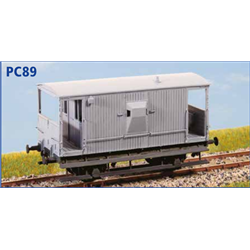Static grass puffer bottles work by manually charging model grass fibres with static electricity. When the charged...
No products
Product successfully added to your shopping cart
There are 0 items in your cart. There is 1 item in your cart.
Search Tips
What is a GWR "Toad" brake van?
The GWR "Toad" brake van is a distinct and iconic piece of railway history in the UK. These brake vans were a crucial part of freight trains from the late 19th century through to the mid-20th century. The term "Toad" was the code name given by GWR to its brake vans, following the company's practice of assigning animal names to various types of rolling stock.
The primary purpose of a brake van like the "Toad" was to provide additional braking power for freight trains, particularly on long or heavy trains where the locomotive's brakes alone wouldn't suffice. This was especially important before the widespread adoption of continuous automatic brakes. The brake van housed a hand-operated brake system that the guard, stationed inside, could engage to assist with slowing or stopping the train. The guard would also use the brake van to monitor the condition of the train and signal to the driver if necessary.
"Toad" brake vans were easily recognisable by their boxy shape and large veranda at one end, where the guard would stand when observing the train. These verandas were typically fitted with a handrail and a set of lamps for signalling. Inside, the brake van had a small enclosed cabin, which served as an office and shelter for the guard, often fitted with basic furnishings like a bench, stove and desk. The design was practical, sturdy and suited to the needs of a guard travelling long distances in all weather conditions.
In terms of construction, the "Toad" brake vans were predominantly wooden, with a metal chassis for strength and durability. Different variations of "Toads" were built over the years, but the overall design remained consistent. The van's large, heavy-duty wheels and robust frame allowed it to withstand the rigours of industrial rail transport. Depending on the class of the brake van, its length and weight could vary, but most were fairly compact, designed to bring up the rear of the train without taking up excessive space.
The guard's role within the brake van was not just limited to operating the brakes. They were responsible for maintaining the train’s safety, ensuring that the couplings between wagons were secure and that the load was stable. In the event of an emergency, such as a wagon becoming detached or a coupling breaking, the guard would be able to apply the brakes and bring the train to a halt. This role was critical in an era where freight trains could stretch for miles and communication between the front and rear was limited.
The GWR "Toad" brake van is now a popular piece of history with railway enthusiasts and heritage railways across the UK. Many have been restored and are now part of preserved railway collections, often still used in demonstrations of historical freight workings. Seeing one in action gives a real sense of how freight trains operated before modern braking systems took over.
Click here to receive the tips weekly in your mailbox. You can unsubscribe at any time.









